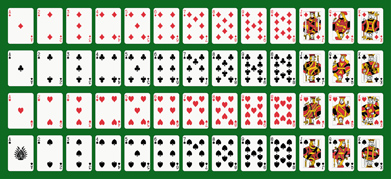Lesson 2
Completion requirements
Created by IMSreader
1. Lesson 2
1.4. Explore 2
Module 1: Probability
In Try This 3 you may have noticed that the theoretical and experimental probabilities were similar. Also, the experimental probability came closer to the theoretical probability as you did more trials. In the next activity you will determine some theoretical probabilities for events more complex than flipping coins.
Let’s experiment with a deck of cards.
Try This 4

© Mannaggia/23299310/Fotolia
A standard deck of playing cards consists of 52 cards labelled as follows:
- Four suits include spades, hearts, diamonds, and clubs.
- Two suits are red: hearts and diamonds.
- Two suits are black: spades and clubs.
- In each suit there are 13 members: ace, 2, 3, 4, 5, 6, 7, 8, 9, 10, jack, queen, and king.
- Jacks, queens, and kings are called face cards.
If you were to randomly draw a card from a shuffled deck, find the probability for each of the following questions.
- What is the probability that the card would be a 2 of hearts?
- What is the probability that the card would be a spade?
- What is the probability that the card would be a face card?
- What is the probability that the card would be a black 9?
- Suppose you drew a card and looked at it. You then returned the card to the deck, shuffled the deck, and repeated the process until you had looked at 20 cards. How many times would you expect to see the following?
- a red card
- a face card
- a 7 of clubs
![]() Save your responses in your course folder.
Save your responses in your course folder.